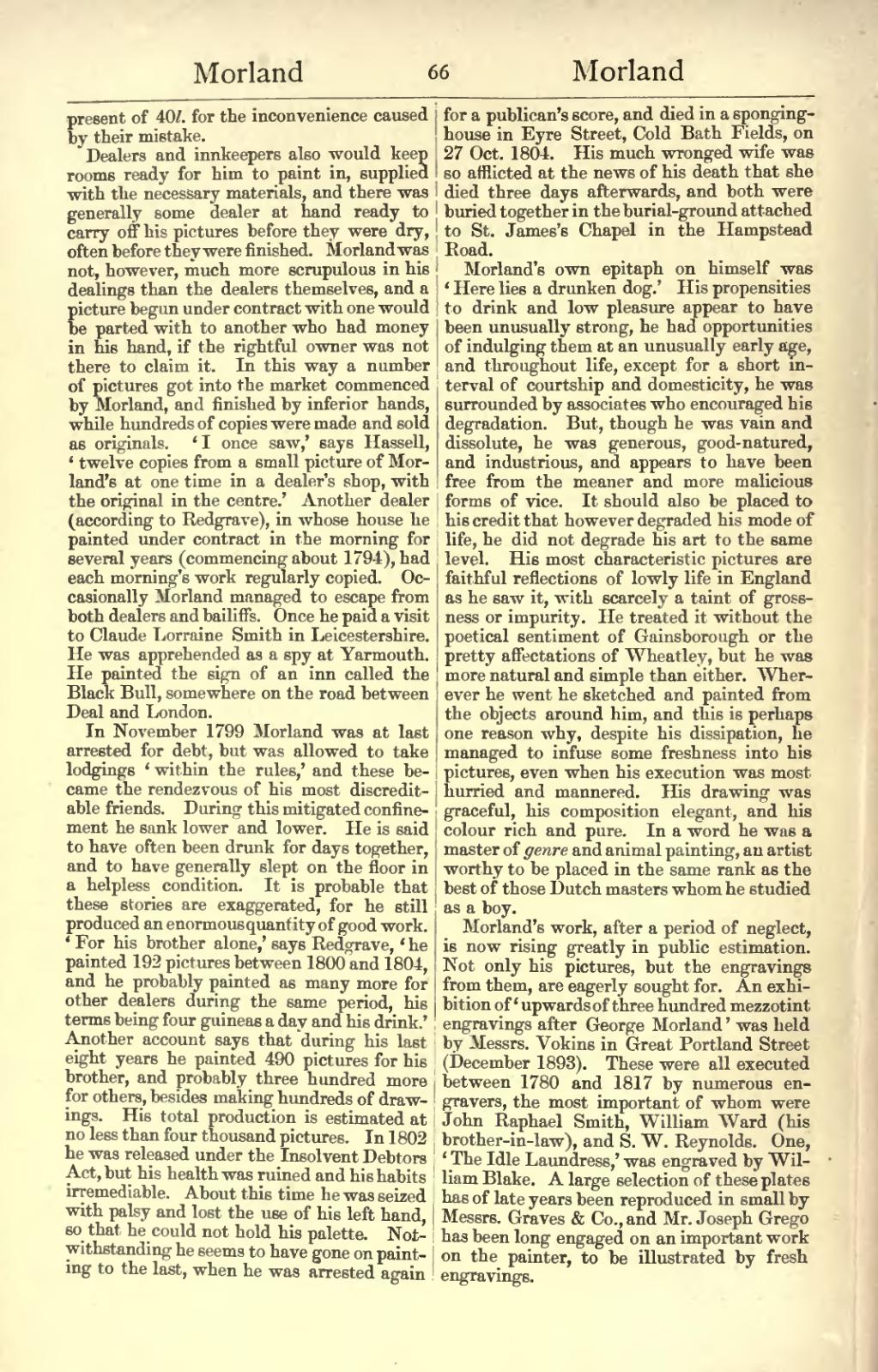present of 40l. for the inconvenience caused by their mistake.
Dealers and innkeepers also would keep rooms ready for him to paint in, supplied with the necessary materials, and there was generally some dealer at hand ready to carry off his pictures before they were dry, often before they were finished. Morland was not, however, much more scrupulous in his dealings than the dealers themselves, and a picture begun under contract with one would be parted with to another who had money in his hand, if the rightful owner was not there to claim it. In this way a number of pictures got into the market commenced by Morland, and finished by inferior hands, while hundreds of copies were made and sold as originals. 'I once saw,' says Hassell, 'twelve copies from a small picture of Morland's at one time in a dealer's shop, with the original in the centre.' Another dealer (according to Redgrave), in whose house he painted under contract in the morning for several years (commencing about 1794), had each morning's work regularly copied. Occasionally Morland managed to escape from both dealers and bailiffs. Once he paid a visit to Claude Lorraine Smith in Leicestershire. He was apprehended as a spy at Yarmouth. He painted the sign of an inn called the Black Bull, somewhere on the road between Deal and London.
In November 1799 Morland was at last arrested for debt, but was allowed to take lodgings 'within the rules,' and these became the rendezvous of his most discreditable friends. During this mitigated confinement he sank lower and lower. He is said to have often been drunk for days together, and to have generally slept on the floor in a helpless condition. It is probable that these stories are exaggerated, for he still produced an enormous quantity of good work. 'For his brother alone,' says Redgrave, 'he painted 192 pictures between 1800 and 1804, and he probably painted as many more for other dealers during the same period, his terms being four guineas a day and his drink.' Another account says that 'during his last eight years he painted 490 pictures for his brother, and probably three hundred more for others, besides making hundreds of drawings. His total production is estimated at no less than four thousand pictures. In 1802 he was released under the Insolvent Debtors Act, but his health was ruined and his habits irremediable. About this time he was seized with palsy and lost the use of his left hand, so that he could not hold his palette. Notwithstanding he seems to have gone on painting to the last, when he was arrested again for a publican's score, and died in a sponging-house in Eyre Street, Cold Bath Fields, on i 27 Oct. 1804. His much wronged wife was so afflicted at the news of his death that she died three days afterwards, and both were buried together in the burial-ground attached to St. James's Chapel in the Hampstead Road.
Morland's own epitaph on himself was 'Here lies a drunken dog.' His propensities to drink and low pleasure appear to have been unusually strong, he had opportunities of indulging them at an unusually early age, and throughout life, except for a short interval of courtship and domesticity, he was surrounded by associates who encouraged his degradation. But, though he was vain and dissolute, he was generous, good-natured, and industrious, and appears to have been free from the meaner and more malicious forms of vice. It should also be placed to his credit that however degraded his mode of life, he did not degrade his art to the same level. His most characteristic pictures are faithful reflections of lowly life in England as he saw it, with scarcely a taint of grossness or impurity. He treated it without the poetical sentiment of Gainsborough or the pretty affectations of Wheatley, but he was more natural and simple than either. Wherever he went he sketched and painted from the objects around him, and this is perhaps one reason why, despite his dissipation, he managed to infuse some freshness into his pictures, even when his execution was most hurried and mannered. His drawing was graceful, his composition elegant, and his colour rich and pure. In a word he was a master of genre and animal painting, an artist worthy to be placed in the same rank as the best of those Dutch masters whom he studied as a boy.
Morland's work, after a period of neglect, is now rising greatly in public estimation. Not only his pictures, but the engravings from them, are eagerly sought for. An exhibition of 'upwards of three hundred mezzotint, engravings after George Morland' was held by Messrs. Vokins in Great Portland Street (December 1893). These were all executed between 1780 and 1817 by numerous engravers, the most important of whom were John Raphael Smith, William AVard (his brother-in-law), and S. W. Reynolds. One, 'The Idle Laundress,' was engraved by William Blake. A large selection of these plates has of late years been reproduced in small by Messrs. Graves & Co., and Mr. Joseph Grego has been long engaged on an important work on the painter, to be illustrated by fresh engravings.
